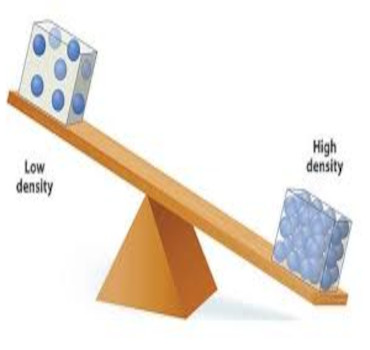INSULATION DENSITY FORMULA
The insulation density refers to the weight per unit volume of a material and is measured in kg/m3. A high density material maximises the overall weight and is an aspect of 'low' thermal diffusivity and 'high' thermal mass.

INSULATION DENSITY KG/M3
Density can be calculated using the formula:
d = m ÷ v
d = density,
m = mass,
v = volume
The greater the density, the more mass per unit volume.
Pic.Insulation density scale.
WHAT IS THE DENSITY OF MATERIALS FOR INSULATION?
The effect of density on product properties varies among different insulation materials, and this holds true even within the category of various mineral wool insulation materials (Glasswool, Stone Wool). Therefore, comparing different materials solely based on their density is not useful. However, it's worth noting that insulation materials are typically produced with a minimum density of 10 kg/m³.
An example of such insulation is the widely popular loft roll. For soundproofing walls or ceilings, materials with high density are used, such as rock wool RWA45, RW3, or RW5. Insulating floors in homes, garages, or car parks often involves materials like PIR, commonly recognized under brands like Celotex or Unilin, with a density starting from 30 kg/m³.
HOW DOES DENSITY AFFECT INSULATION?
Higher temperatures lead to higher thermal conductivities and the lower is the material density, the higher is the thermal conductivity. Density has an effect mainly on mechanical properties of an insulation material. This means that density informs us whether we can use this type of insulation for insulating, for example, floors. Low density of the insulation product excludes its use in places susceptible to heavy static loads. Therefore, using wool for insulating a floor would not be suitable.
INSULATION DENSITY CHART
Insulations, whether used for ceiling, floor, or walls, have a specific purpose - to efficiently and optimally maintain a designated temperature inside a room. The density of insulation depends proportionally on where they are used.
For instance, for floors, insulation materials with a density higher than 32 kg/m³ are used, while for walls and insulation between joists, not less than 10 kg/m³ is recommended.
Below is the insulation density chart
- XPS Extruded polystyrene - 35kg/m3
- EPS Expanded polystyrene - 20kg/m3
- PIR rigid boards - 30 – 32 Kg/m3
- Glass wool - 10kg/m3
- Rock wool - 45kg/m3, 60kg/m3, 100kg/m3
- Phenolic foam - 35kg/m3
WHAT IS THE DENSITY OF WOOL INSULATION?
Typical mineral wool densities range from 10 kg/m³ to 100 kg/m³. Such a significant variation in product density is associated with its intended application. For areas that do not require high density, such as insulation between joists, mineral wool with relatively low density is used. Unfortunately, the lower the density of the insulation product, the higher its thermal conductivity. Higher thermal conductivity means that the material will conduct heat more quickly. Meanwhile, for ceiling insulation and soundproofing, rock wool is utilised, with a density reaching 100 kg/m³, enabling the quieting of a room by up to 40 dB.
Related Searches:
DIFFERENCE BETWEEN EPS AND XPS INSULATION BOARDS
BEST FLOOR INSULATION - THE COMPLETE GUIDE
*Insulationgo LTD strives to keep the content accurate and up-to-date, but we cannot be held responsible for any mistakes or exclusions.
The information in this article isn't expert advice and shouldn't replace talking to the right specialists. Before buying or deciding anything based on this info, it's best to contact the product manufacturer directly to double-check if it's right for what you need.
Descriptions, drawings, photographs, data, proportions, weights, and measured values provided here may change without prior notice and do not establish the guaranteed contractual quality of the products. The recipient of these products holds the responsibility to comply with proprietary rights, existing laws, and legislation.
Using this articles implies acknowledgment and agreement that Insulationgo LTD cannot be held accountable for any damages, losses, or inconveniences resulting from the use or reliance upon the information provided. This limitation of liability extends to all users of the article, including visitors, readers, and subscribers.










































































































